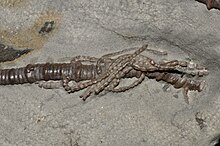| Agaricocrinus americanus Temporal range: Lower Mississippian, 345 Ma PreꞒ Ꞓ O S D C P T J K Pg N ↓ | |
|---|---|

| |
| Calyx with arms and pinnules | |
| Scientific classification | |
| Kingdom: | Animalia |
| Phylum: | Echinodermata |
| Class: | Crinoidea |
| Family: | Coelocrinidae |
| Genus: | Agaricocrinus |
| Species: | A. americanus |
| Binomial name | |
| Agaricocrinus americanus | |
Agaricocrinus americanus, also known as the mushroom crinoid or American crinoid, is a species of extinct crinoid. Its fossils can be found in the U.S. states of Indiana, Tennessee and Kentucky. They date back to the Lower Mississippian, about 345 million years ago.
Fossil beds
One of the locations from which Agaricocrinus americanus is known is the Edwardsville Formation, in the vicinity of Crawfordsville, Montgomery County, Indiana, in the United States. In this fossil-rich bed have been found the fossils of sixty species of crinoid, distributed among more than forty genera. It is thought that the various species had different length stalks so that they could capture plankton drifting past at various heights above the substrate. The fossil beds were formed at a time when the seabed was much higher than it is today. It is believed that the crinoids were buried in sediment from nearby deltas during storms. The resulting siltstone deposits are soft enough for the fossils to be extracted in three-dimensional relief.

Other fossils of this species have been found in similar sedimentary rocks in Whites Creek in Davidson County, Tennessee, from Osagean rocks in Kentucky, and more recently from the Fort Payne Formation near the boundary between Tennessee and Kentucky. Certain morphological differences have been found between various specimens from these different locations and new finds have often been claimed as new species. David Meyer and William Ausich studied the genus Agaricocrinus in 1997 and proposed that A. arcula, A. dissimilis, A. elegans, A. podagricus, A. ponderosus, A. profundus and A. tugurium should be brought into synonymy with Agaricocrinus americanus. A closely related but less common species is Agaricocrinus crassus.
Description
Like extant crinoids, Agaricocrinus americanus was anchored to a hard surface by a holdfast out of which grew an articulated stalk. On top of this was a calyx with a number of feather-like arms. Each arm bore short branches known as pinnules and from these cirri were extended which sifted plankton from the water flowing past.
References
- "Agaricocrinus americanus". Virtual Fossil Museum. Retrieved 2013-01-30.
- "Crawfordsville crinoids". Virtual Fossil Museum. Retrieved 2013-01-30.
- Meyer, David L.; Ausich, William I. (1997). "Morphologic Variation within and among Populations of the Camerate Crinoid Agaricocrinus (Lower Mississippian, Kentucky and Tennessee): Breaking the Spell of the Mushroom". Journal of Paleontology. 71 (5): 896–917. JSTOR 1306565.
- Dorit, R. L.; Walker, W. F.; Barnes, R. D. (1991). Zoology. Saunders College Publishing. pp. 790–792. ISBN 978-0-03-030504-7.